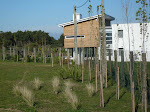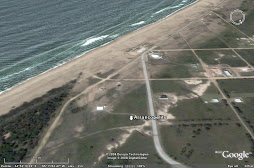
View of Punta del Este from Punta Ballena
Punta del Este and its area of influence covers mellow, long bays with island views, stretches of rough ocean, peaceful lake or riverfront estates, lushly landscaped urban neighborhoods, golf communities, recreational or working farms and ranches, vineyards or orchards, glitzy Miami-style condos, Tudor-style mansions, modernist villas set amid dunes and pine forests resembling the Hamptons geography, or condos within walking distance to the beach and the harbor.
This diversity of landscape, setting and lifestyle (patrician Argentines; celebrity Brits seeking solitude and anonymity; nouveaux riche from all over looking to make a splash; gays from the region and beyond enjoying Punta’s renowned gay-friendly atmosphere, or, more than anything really, families from Argentina, Brazil, Paraguay and Uruguay having their annual vacation/reunions), has been the key element driving the growth of Punta del Este.
Two traditions rolled into one, the brisk walk around the pensinsula, and an optimist race in the backround
But today “greater Punta del Este” – that stretch of coast extending from Laguna del Sauce to Laguna Garzón – is taking the leap from the merely “upscale” to the truly “luxury” market. And as the price-tags boldly reach into million-dollar territory and beyond, this new real-estate boom may provide those living off the Punta del Este economy with a true hedge against the always volatile Argentine economy, while achieving that as yet elusive goal: extending its ludicrously short season. For those just visiting or spending time, it will multiply the offering of infrastructure, services and entertainment, making it more attractive year-round.
Views of Acqua, Viñoly´s Punta opusMany dynamics are at work simultaneously, providing a confusing picture. What appears to be an increasingly shorter season – the hot and trendy time to see and be seen has shortened to the three weeks between Dec.26 and Jan 15, as opposed to the entire month of January as was customary for decades – belies the increasing population of Punta del Este throughout the year, and in particular during the months of October through April. So while the soap-opera star du jour may only make a one or two week appearance in early January, many formerly summer visitors are spending time throughout the year, with some settling in the spring and refusing to leave until the fall.

View from penthouse terrace at Quay, the only new development on the harbor
This is a continuation and intensification of a phenomenon triggered by the latest Argentine economic crisis and its spike in violent crime. Many who could moved to live in Punta in order to avoid a wave of kidnappings that affected Buenos Aires, thus triggering a boom in private school investment, while other home-owners chose to make it a six-month summer, as opposed to the previously Dec. through Feb. season.
Brava 28, one of the new, amenity-ridden complexes on the Brava side

El Caracol, the hottest of the hot. Atlantic Ocean on the left, Laguna Garzón on the right
The intense growth in the upper end of the market is in stark contrast with the desertion by the middle classes of Uruguay, Argentina and southern Brazil, which traditionally – despite all hype to the contrary – made the bulk of the resort’s summer population. As a result, while the gold rush sweeps certain segments of the Punta del Este economy, the cries of “Punta del Este is over” can be heard from those – and they are many – trying to rent out a 25 year-old, never-refurbished, 70 m2 condo. Because there are thousands of these properties which have not been renovated and which are furnished with whatever was dug out from the garage in Montevideo or Buenos Aires decades ago, owners find themselves increasingly priced out from an ever-fancier resort, while deprived from the rental income that used to cover their annual expenses.
The Iglesias family has done it before in Punta Cana. This is their Laguna Estates, in the Laguna Blanca area.
Meanwhile, condos at Acqua, the striking new building by Uruguayan superstar architect Rafael Viñoly have been selling for $3 million and $5 million. Buyers that we know of so far include a Paris-based Argentine, a Swiss investment manager who signed up for two units, and a British national. Gray Stone, another tony development with 700 m2 condos, is listed at $1.3M per pad.
The chacras phenomenon – farms that are mostly recreational – does not seem to abate. One famous Argentine oil baron is busing in several hundred people from the nearby working-class town of San Carlos to work on the construction and upkeep of a landing strip, 18-hole golf course, vineyards and olive groves in his property in the vicinity of Jose Ignacio. But beyond this chacra-on-steroids, there are dozens upon dozens on the market, ranging from $250k for a couple hectares of land and likely a tear-down or no house, to around $2.5M which usually buys you a few hectares of land and a massive house set on high ground with views of some body of water, sometimes with lake and ocean views.
Le Club, a boutique hotel in La Barra that is always a bit snooty and pricey, but still perfect for lunch or sunset drinks
New, luxury-project launches have ceased to surprise. European funded Swan Lake Forest, in the Laguna del Sauce area, will be a golf-centered villas/condos project including a hotel, while a similar project on the Cerro del Burro hillside in Punta Negra developed by Spanish and Indian investors will command Laguna del Sauce and ocean views all the way to Punta del Este, some 25 km away. The Brazilians behind the super-luxury Cidade Jardin project in Sao Paulo plan to develop a 500 hectare plot in Punta del Este that will include a Fasano resort – Brazil´s answer to Cipriani – with a projected final sale value of $440 million, while the developers behind Nordelta in Argentina (a gated community the size of an entire municipality whose buyers camp out the night before when new plots go on sale) are rumored to have acquired land for a similar project. The Laguna Estates project near La Barra, developed by Spanish investors related to Julio Iglesias is also targeting the top end of the market. Meanwhile, in and around Jose Ignacio and Laguna Garzón (the new José Ignacio) the luxury projects are piling up with the common denominator of large plots of land per property and large tracts of undeveloped common land.
In terms of new condo and off-plan sales, the hottest price-point right now is around $300k to $450k for 120 to 200m2 condos. This is a departure from previous booms in Punta del Este where high-rise development targeted the middle class with 60 to 100 m2 properties cramming in up to 3 bedrooms plus maid’s quarters, with zero amenities.
Many of our Argentine clients with existing summer homes have been buying one, two or three new condos at $1,800 to $2,500 per m2 for investment purposes. The recent launch of Marigot Brava off-plan sales stunned the market by allegedly selling out its 30-something condos on its first day of sales.
These properties are usually amenity-loaded developments, with several highrises on the Mansa side (the more gaudy, Miami-like stretch of Punta del Este) listing prices of $300k for a two or three bedroom, and up to $700 or $800k for their penthouse extravaganzas, while the classier, more low-key new buildings on the Brava side are priced even higher.
In the area fronting the harbor, it´s almost impossible to find anything under $400k or $500k among resale condos, with just a single new project underway, Quay, with prices in the $1.2 million range. In fact, anything with harbor views is outperforming other properties more than ever before, regardless of the unit's condition, with an old but fully renovated property with harbor views commanding the same m2 price than new developments loaded with the features and amenities that usually older harbor-side properties lack.
Therefore, barring outstanding views and a buyer with a thing for extreme, knock-down-every-wall renovations, that 20 year-old, 90 m2 3-bedroom condo listed at $110k may have a hard time finding a buyer. There are no buyers for shabby any more, because those who are OK with shabby usually have an issue with prices at the supermarket or the restaurant, or feel intimidated by the fleets of luxury cars at the beach parking lot. So it is that a large portion of the shabby property market remains unrented or unsold despite an otherwise booming market.For extra-regional potential buyers, the opportunities presented by what I call the shabby market are plentiful. After all, what may be a pricey restaurant meal or grocery bill to a middle class Uruguayan or Argentine translates into "very reasonable" to "downright cheap" depending on where in the Northern hemisphere one has been dining and shopping. The contrast is even sharper in terms of real estate pricing. A house or condo set in beautiful wooded neighborhoods and within walking distance to the beach can be found for $100k, and with another $50k the buyer can end up with a fully renovated property with a nice garden and even a pool. The less trendy the area, the more mature the gardens and lower the prices. There are still beachfront one bedroom condos to be found for under $100k in out-of-fashion areas.
But for those in the luxury segment, opportunities may be even greater, as the price difference with other luxury destinations is still huge, therefore providing more upside potential. When the price-gap between locations is between four and up to ten-fold (in the case of properties with large tracts of land in particular), it’s not so crazy to expect that as Punta del Este consolidates in the international luxury destination circuit, prices will rise enough to somewhat narrow this gap.
The abundance of still relatively cheap land, reasonable zoning laws preserving green and unbuilt ratios while allowing highrise development in restricted areas, a summer season during the Northern winter with benign, non-tropical temperatures, and the abundance of water resources -- as opposed to the dry-and-getting-dryer Mediterranean -- should keep extra-regional buyers coming in greater numbers over the next few years, once and for all establishing Punta del Este as a truly international destination and making it ever more attractive for year-round living.








No comments:
Post a Comment